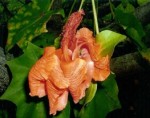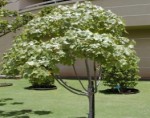Scientific Name: Kokia drynarioides
Endemic: Hawaii Island Only
Description: A beautiful hibiscus tree with large maple-like leaves and gorgeous salmon colored flowers with petals that ruffle and tweak backwards, very unusual. This plant can be quite tall for a hibiscus, reaching heights of up to 25 ft. plus.
Distribution: This federally listed endangered tree is endemic to the island of Hawaii where it is found in the upper dry forest and ‘a’a lava fields of North Kona. It is extremely rare in the wild with only two plants remaining.
Cultural Uses: A pinkish dye can be made from the flowers of this plant as well as a darker reddish dye derived from the bark used to color fishnets. There is also documentation of the flowers being used for lei. A good picture of this plant used in lei can be seen in the book Na Lei Makamae by Paul Weisich and Marie McDonald.
Landscape Use and Care: This magnificent tree, if available, should be planted in more yards and gardens. Mature trees bloom profusely from late summer to early fall. Good drainage is key for this plant to thrive, and requires little to no watering once established in the ground. We have a variegated plant of this in the ground at our nursery in fairly poor, but dry soil, doing very well. My neighbor in Waimanalo also has one that is absolutely jamming and looking great. The soil there is also very dry but very sandy which allows for good drainage. Occasionally, white flies accumulate on the undersides of the leaves, store bought pesticides should take care of that with no harm to the plant as long as the directions are followed. Try and stay away from oil based pesticides, these may burn the leaves. If you notice crinkling of the leaves with soft white powdery mass at the base of the leaves and a lot of ants, then those are mealy bugs. The ants farm the mealy bugs to harvest a sugary substance they secrete while feeding on the plant. Kill the mealy bugs by smashing them or cutting off the portion if it is really bad. After that get rid of the ants with pesticides and that should remedy the problem.
Additional Info: Kokia is an endemic genus to Hawaii represented by four different species: Kokia drynarioides, discussed here from the Big Island; Kokia kauaiensis another endangered species from Kaua’i; Kokia cookei from Molokai, often referred to as the rarest plant in the world since it usually exists as grafted clones to the other two species mentioned above but now actual seeds from mature grafts have been germinated which is good because it allows for genetic recombination which could overall produce a stronger plant that in the long run will strengthen the species; and finally, Kokia lanceolata from O’ahu, it was last documented in 1888 near Koko Head and in Wailupe, it has not been seen since then and is now presumed extinct.
Hauheleula

